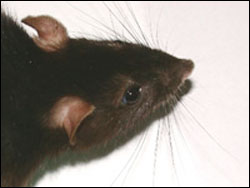Rat Whisking May Provide Insight Into Debilitating Eye Disorder

A rat’s whiskers Credit: Samar B. Metha, UCSD
Physicists at the University of California, San Diego have discovered a neural circuit in rats that could provide a powerful model for understanding a neurological condition known as blepharospasm—uncontrolled eye blinking that affects 50,000 people in the U.S. and leaves some patients functionally blind.
In the February 3 issue of the journal Neuron, the researchers, Quoc-Thang Nguyen and David Kleinfeld, describe the brain circuit, which coordinates sensory inputs and muscle activity in rats’ whiskers. It is the first discovery of a reflex circuit that functions to boost the amount of incoming sensory information. Because the neural wiring of the rat whiskers appears to be identical to the circuit that controls eyeblinking in humans, the UCSD scientists believe it could be used for pioneering new treatments for blepharospasm.
“We have been studying the rat whisker system as an example to help us understand how sensory systems control where the sensors are in space and how the sensors are moved,” said Nguyen, an assistant project scientist in UCSD’s physics department. “Our study is the first to find a neural circuit responsible for keeping sensors on an object during active touch.”
“We hope that this finding will help push the field from a focus biased by anatomy to a focus centered on functionality of neural circuits,” added David Kleinfeld, a professor of physics at UCSD. “Also, this circuit could serve as a model system to deepen our understanding of a pathology in the human eyeblink circuit.”
The only neural circuits controlling reflexes that had been identified prior to the UCSD physicists’ discovery were negative feedback loops, in which sensory input leads to motor output that withdraws sensors from the source of a stimulus. For example, such a reflex occurs if you accidentally touch a hot stove.
On the other hand, the newly discovered reflex circuit that controls rats’ whiskers as rats explore their environment is a positive feedback loop. It helps rats keep their whiskers on an object, enabling them to gather an uninterrupted stream of sensory information.
Nguyen commented that positive feedback loops make engineers “squeamish” because, if uncontrolled, they can create a vicious cycle. For example, in a furnace controlled by positive feedback, rather than negative feedback, the warmer a room became the more the thermostat would signal the furnace to turn on.
This type of vicious cycle appears to occur in blepharospasm. Normally, the blinking reflex protects the eye from bright light and other environmental hazards, but in blepharospasm this blinking response gets out of control. The resulting muscle spasms can be so intense that the eyelids remain forcefully closed for several hours at a time.
“The human eyeblink reflex circuit appears to share a common anatomy and physiology with the neural circuit that controls rat whiskers,” said Kleinfeld. “Actually, it isn’t unusual to see the repetition of neural circuits with the same design principles in different systems.”
As with blinking in humans, rat whisking does not normally turn into a vicious cycle. However, certain chemicals that interfere with normal communication between nerve cells can cause unintentional whisking in rats. By studying what mechanisms usually keep rat whisker movements in check, researchers can develop a better understanding of what causes the eyeblink reflex to go awry.
“Until now, treatment for blepharospasm has been mostly trial and error,” said Nguyen. “Our findings should permit a more principled approach to the development of new medications and therapies.”
The researchers also said their findings underscore the importance of basic scientific research. Nguyen called the connection to blepharospasm a “serendipitous” outcome of their work. Kleinfeld added that their finding is just one example that shows the growing trend to fund research on diseases at the expense of basic science may be unwise and counterproductive.
“We need to understand how a system works when it is normal in order to understand what goes wrong when it is broken,” he said.
Their research was supported by grants from the National Institutes of Health and the Human Frontiers Scientific Program.
Media Contact
More Information:
http://www.ucsd.eduAll latest news from the category: Physics and Astronomy
This area deals with the fundamental laws and building blocks of nature and how they interact, the properties and the behavior of matter, and research into space and time and their structures.
innovations-report provides in-depth reports and articles on subjects such as astrophysics, laser technologies, nuclear, quantum, particle and solid-state physics, nanotechnologies, planetary research and findings (Mars, Venus) and developments related to the Hubble Telescope.
Newest articles

Pinpointing hydrogen isotopes in titanium hydride nanofilms
Although it is the smallest and lightest atom, hydrogen can have a big impact by infiltrating other materials and affecting their properties, such as superconductivity and metal-insulator-transitions. Now, researchers from…

A new way of entangling light and sound
For a wide variety of emerging quantum technologies, such as secure quantum communications and quantum computing, quantum entanglement is a prerequisite. Scientists at the Max-Planck-Institute for the Science of Light…

Telescope for NASA’s Roman Mission complete, delivered to Goddard
NASA’s Nancy Grace Roman Space Telescope is one giant step closer to unlocking the mysteries of the universe. The mission has now received its final major delivery: the Optical Telescope…



